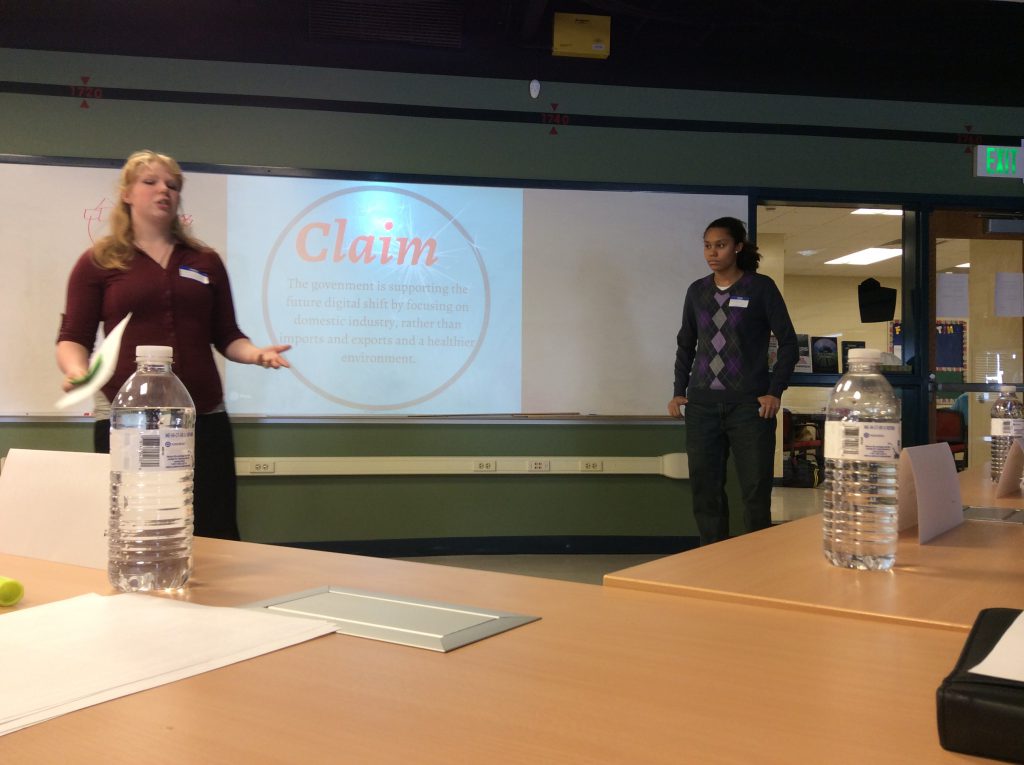
What do today’s trends say about tomorrow’s economy?
What does the future look like for American industry?
That question was recently asked of high school juniors in Ms. Giessler and Mr. Toy’s U.S. History and English classes at the New Tech Academy at Wayne High School in Fort Wayne, Indiana. I was invited to hear their “Shift Happens” presentations; predictions on how industry will evolve and how our future will look because of it. Eleven teams of students took either an environmental, economic, social, or political approach to their research. Here’s what they had to say:
3-D Printing
Many students had a very positive outlook on our future, with predictions that 3-D printing would revolutionize the way America functions. Vaughn’s group noted industrial accidents as a major workplace issue, noting 3-D printing could assist workers who’ve lost their limbs, making robotic arms and legs to help them. Heather’s group predicted 90 percent of our energy needs would soon be met by solar power once we run out of oil, and those solar panels would be made using 3-D printing technology, adding that “we are using more resources than we have already.”
Given the prominence of the auto industry in Northeast Indiana, Ja’ton’s group hoped to boost production of auto parts in the United States, explaining that we would “no longer need to buy many of our car parts from China, we could make more of them here with a 3-D printer.” Joey’s team associated 3-D printing with literally saving lives, printing organs like kidneys, for transplant to those in need. Note: The school has its own 3-D printer, providing hands-on experience to students on a regular basis.
Automation
Two teams of students presented two completely different perspectives on the impact automation would have on future employment. Jonas’ team predicted increased unemployment as the use of robots in the workplace increased, explaining that a robot is able to complete more tasks in a week than a worker could in years. This team stressed the importance of increasing our skills and abilities because there won’t be many jobs available for those without a post-secondary education; robots will be performing those duties. On the contrary, Evelyn’s team looked at automation as an opportunity for growth, not an obstacle. Citing “Baxter the Robot,” her team explained that “instead of letting them [robots] take our jobs, we can work beside them. Also, someone has to make and maintain the robots, which would create more jobs.” They also saw an increase in STEM-related careers because as our technology increases, so does our need to support those technologies. (Note: These two teams did tremendously well to defend two opposing views, and I agree with both of them. Robots, like Baxter, must be programmed and maintained, just as they must be built to begin with, and all of it can be done in the United States. What’s more, advancing our skills and abilities are important for a productive and prosperous economy, with or without the threat of robotic competition. Well done!)
Lots has been written abt robots replacing workers in #mfg but the reality we’re seeing w/customers is the opposite" http://t.co/FbMIUniYLh
— Rethink Robotics (@RethinkRobotics) March 2, 2015
Pollution
Many groups expressed concern for the environment as they looked to the future, with several offering solutions or pointing out contradictory habits that give them cause for concern. Kaytlin’s group predicted an increase in recycling efforts, which would have a positive impact on our environment, while also noting an increase in air-conditioning use, contributing to elevated energy consumption. Our scarce resources will continue to be stretched farther and we’ll soon harvest most of our power from the sun, according to Heather’s group. Abby’s group suggested technology will help protect our environment from industrial greenhouse gas emissions … and with less pollution, there will be less cancer, according to Joey’s group. Hasan’s group most articulately explained that we needed to “change our focus from consumerism to environmentalism.”
The Role of Government
The government will be heavily involved in everyday life in the future, to defend us and to over-tax us, according to several groups. Hasan’s group predicted that with our increasing population, the need to keep the peace will become more crucial and regulation more necessary. John’s group saw our government intervening in the global economy, imposing tariffs on imports as a way to promote and protect our domestic industries. Because of increased tariffs, more products will be made here, creating “a boom in U.S. manufacturing.” Alejandra’s group predicted rampant taxation, asking the question “is the power with the people or the politicians?” Innovative modes of transportation were discussed. (Note: which in turn, must lead to investing in infrastructure to support them.) Celiana’s group saw bullet trains and Google cars as critical to our future.
With every new idea or invention comes an opportunity to elevate our country and economy to new heights. America has certainly seen its share of challenges, yet U.S. industry has still been able to persevere and innovate in order to maintain its status as a dominant world leader. Young people like those in Ms. Giessler and Mr. Toy’s class are key to America’s success in the global arena. Their predictions, concerns and opinions, if taken seriously, can guide this country to be a safer, cleaner, smarter world. But we – and Congress – must hear their hopeful, bright voices leading the charge for a better world.
And the discussion around Bitcoins, we’ll leave for another day…
Thank you to Ms. Giessler, Mr. Toy and their students; a job well done!
